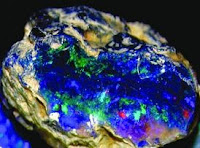 |
| Uncut Black Opal |
Black Opal is considered to be the most beautiful gem in the Opal family. It is characterized by a dark or black background and can be flecked throughout with all the colors of the rainbow. Many ancient cultures believed these phenomenal gems had powers of the unearthly and came from the heavens. Whilst Opal has been found throughout the world on every continent the majority of the world's supply (around 95%) comes from Australia.
Black Opal itself also predominantly comes from Australian mines. The foremost supplier these days being the mines of Lightning Ridge in northern New South Wales, Australia. Other places in Australia where Black Opal has been found is White Cliff, Andamooka and Mintabie in northern South Australia.
Opal belongs to the broad mineral group of Silicates and is part of the Quartz sub category. SiO2.nH2O is Hydrous Silica and the varieties include Black Opal, White Opal, Boulder Opal, Crystal Opal, Volcanic Opal, Wood Opal and Hyalite.
What gives the Opal its fabulous color is the water trapped between the layers of silicate. A typical Opal has around 6% to 10% of water content and in some cases as high as 21%. This not only gives the color diffracting through the layers but also the depth and layering of color throughout the stone.
 |
| Fossilized Black Opal jawbone. |
A lot of Opal was formed in the beds of ancient oceans where the water was trapped in the layers of silicate. In these layers were also trapped microorganisms, small sea life and prehistoric animals. These fossils have on occasion been "Opalized" giving special significance to some of the better specimens of Black Opal found.
